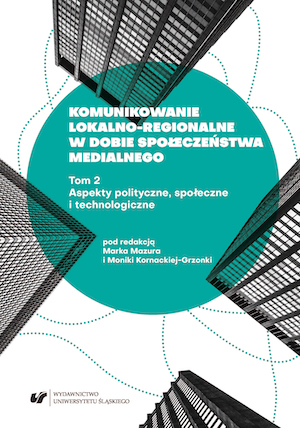MediaEgo w MediaPolis
Lokalizm i regionalizm w pierwszym jasnogórskim przemówieniu Andrzeja Dudy jako przykład strategii wizerunkowej
MediaEgo in MediaPolis
Localism and regionalism in the first speech of Andrzej Duda at the Jasna Góra monastery as an example of an image strategy
Author(s): Agnieszka Walecka-Rynduch
Subject(s): Media studies, Theory of Communication
Published by: Wydawnictwo Uniwersytetu Śląskiego
Keywords: MediaEgo; MediaPolis; political persona; political image creation; neotribalism
Summary/Abstract: The aim of the article is a multifaceted analysis whose foundation consists in the firstspeech of the President of Poland, Andrzej Duda, delivered at the Jasna Góra monastery. Thus,in her analysis, the author refers to other processes which can be observed in the contemporaryMediaPolis, i.e. the public space which combines politics and entertainment by creating a newpolitical identity. It is in that space that a new, personal type of a politician has emerged –MediaEgo. For that reason, in the course of content analysis, the author intends to shed light onthe changes in the paradigm of image creation in the contemporary political discourse. The newpersonal type of a politician which functions in the space of MediaPolis – MediaEgo – utilizesparticular tools, both rhetorical and communicational, in order to permanently influence theelectorate.In this context, the author differentiates the topoi which constitute the public image ofPresident Andrzej Duda. These include: the topos of faith and religious community; the toposof historical community; the topos of the countryside, patriotism and love for one’s motherland;the topos of a people’s hero (an ordinary person) and the topos of the European Union.Their analysis has allowed the author to showcase a multifaceted strategy of the President’simage creation and present a preliminary study of a new model for analysis of contemporarydiscursive processes.The aim of the article is a multifaceted analysis whose foundation consists in the first speech of the President of Poland, Andrzej Duda, delivered at the Jasna Góra monastery. Thus, in her analysis, the author refers to other processes which can be observed in the contemporary MediaPolis, i.e. the public space which combines politics and entertainment by creating a new political identity. It is in that space that a new, personal type of a politician has emerged – MediaEgo. For that reason, in the course of content analysis, the author intends to shed light on the changes in the paradigm of image creation in the contemporary political discourse. The new personal type of a politician which functions in the space of MediaPolis – MediaEgo – utilizes particular tools, both rhetorical and communicational, in order to permanently influence the electorate.In this context, the author differentiates the topoi which constitute the public image of President Andrzej Duda. These include: the topos of faith and religious community; the topos of historical community; the topos of the countryside, patriotism and love for one’s motherland; the topos of a people’s hero (an ordinary person) and the topos of the European Union. Their analysis has allowed the author to showcase a multifaceted strategy of the President’s image creation and present a preliminary study of a new model for analysis of contemporary discursive processes.
- Page Range: 11-29
- Page Count: 19
- Publication Year: 2019
- Language: Polish
- Content File-PDF

